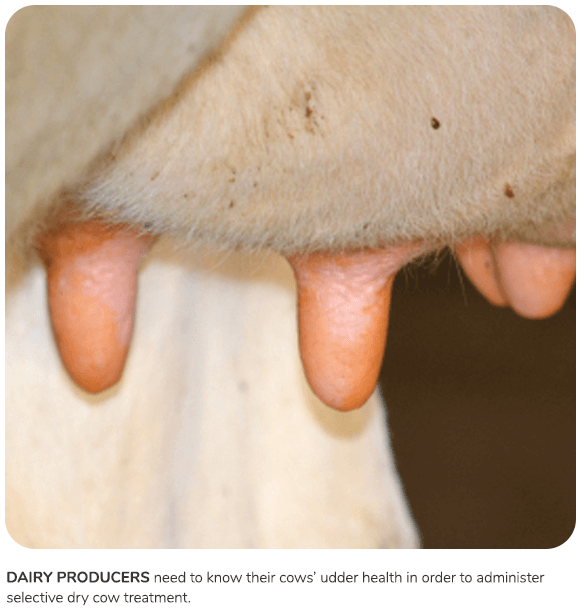
By Dr. Rob Tremblay, DVM, DVSc, Dipl ACVIMis a bovine specialist for Boehringer Ingelheim Animal Health.
Treating cows with an intramammary antibiotic at dry-off has been a standard recommendation for mastitis control for several decades.
The National Mastitis Council (NMC) recommends using intramammary antibiotics as part of an effective dry cow management, and suggests treating all quarters of the udder even if there is no evidence the quarter is infected. This is often called blanket dry therapy.
All agricultural sectors are looking at how antibiotics are used, especially in situations where there is no evidence that bacteria are present. In dairy, blanket dry cow treatment is one of those situations. There are several reasons why dry treatment is often the best way to cure some types of mastitis and improve milk quality and udder health. Researchers understand the value of dry cow treatment but they are asking if there is a way to reduce routinely treating cows that are not likely to benefit from treatment.
When researchers look at how we manage late lactation and dry cows, they ask if there is an easy way for veterinarians and farmers to identify cows that don’t need to be treated with an intramammary antibiotic at dry-off.
There are several reasons why dry treatment is often the best method to cure some types of mastitis and improve milk quality and udder health. Researchers are not condemning dry cow treatment, but instead, looking at other methods to manage dry-off cows, and inquiring whether there is a way to decrease treating cows that don’t need to be treated.
The proposed alternative to blanket dry cow therapy is selective dry cow treatment, also known as targeted dry cow therapy because it targets cows most likely to benefit from treatment at dry-off.
To target cows, producers need to know their cows’ udder health. Most experts in Europe and North America believe the first step is to look at the bulk tank somatic cell count (SCC), which should be less than 250,000 on a rolling basis before producers can consider using a targeted dry cow program.
For herds under 250,000 SCC, the next step is to look at the udder health information available for those cows. Individual SCCs and clinical mastitis records, especially in the last 90 days before dry-off, are important. It’s good to know about all clinical mastitis cases even if producers didn’t treat the mastitis. This information can be used to predict which cows would benefit the most from dry cow therapy. If producers can get milk culture information or test results, such as results from CanWest DHI’s Mastitis4 test, it would help improve dry-off decisions.
When producers identify cows most likely to benefit from an intramammary antibiotic treatment, they should treat all quarters of the udder with antibiotics. Most mastitis experts also recommend using an internal teat sealant.
When udder health experts evaluate the benefits of intramammary treatment at dry-off, they look beyond just curing quarters that were infected before dry-off. They also consider whether dry treatment protects against a quarter becoming infected during the dry period.
Just after dry-off is a critical time because the natural plug that seals the teat takes time to form, leaving the cow vulnerable. Using an internal teat sealant can reduce that vulnerability, which is why experts recommend all cows receive an internal teat sealant even if they do not get an intramammary antibiotic treatment.
When producers administer intramammary products, it’s important they’re careful to make sure the process is as clean as possible and to follow proper technique, which includes dipping each teat with an approved teat dip after the last infusion. Proper technique also helps ensure teat sealant is properly placed in the teat.
The Canadian Bovine Mastitis and Milk Quality Research Network offers techniques on proper infusion on its website at www.mastitisnetwork.org










